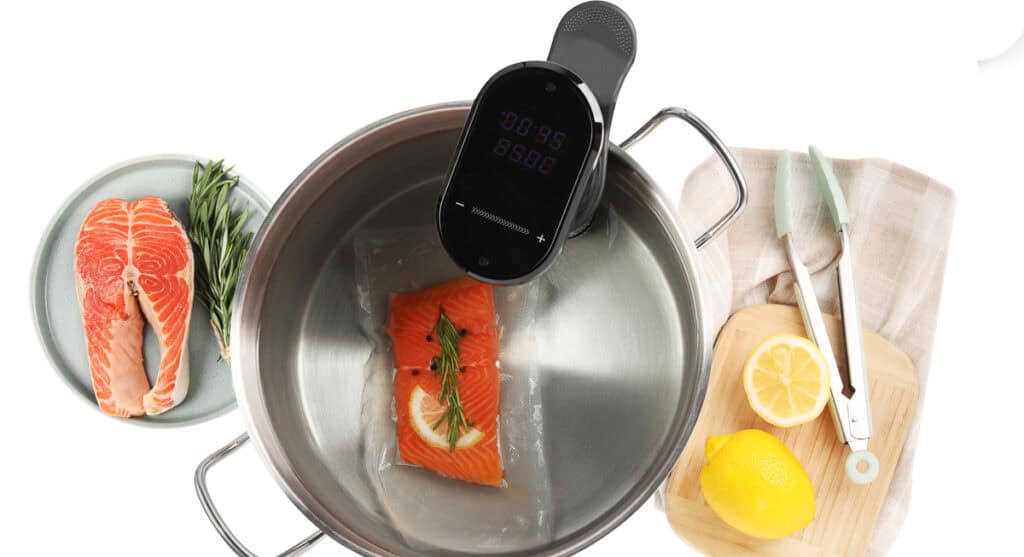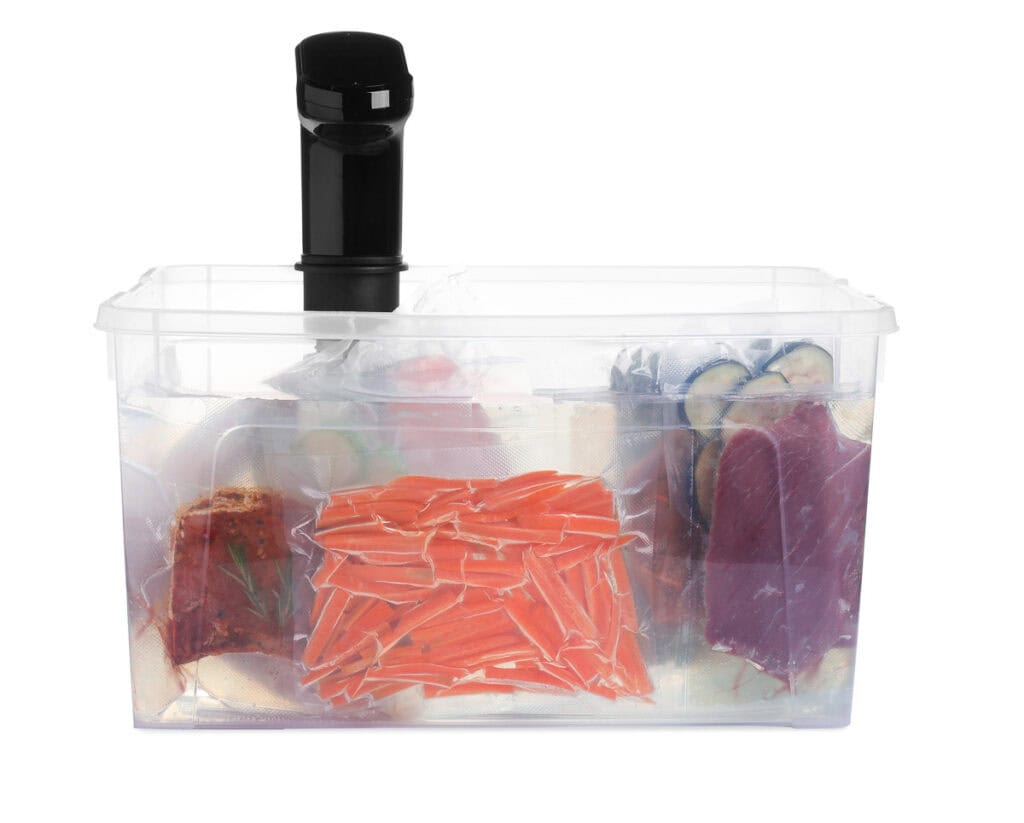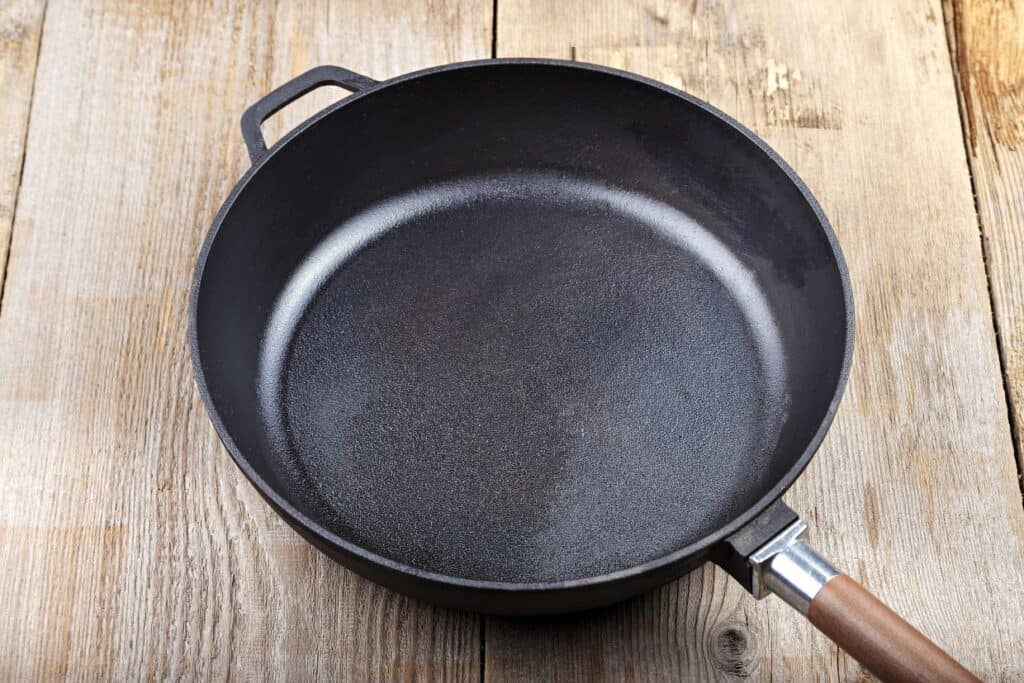Once you begin sous vide cooking, you quickly realize why it’s become such a popular method. There’s something magical about consistently producing perfectly cooked meals every time. The right sous vide accessories can take your experience from good to gourmet.

This post may contain affiliate link(s). As an Amazon Associate, I earn from qualifying purchases. See Disclosures.
From specialized containers to precision gadgets, the world of sous vide accessories is full of possibilities. A few key items can make a significant difference in how you cook and enjoy your food.
Best immersion circulator
The only thing you absolutely have to buy for sous vide cooking is an immersion circulator. This precision cooker keeps the water temperature at the exact temperature needed for cooking.
If you don’t already have one, the Anova Precision Cooker 2.0 is my top choice. It is easy to use and comes with wifi connectivity. The wifi lets me monitor the cooking process anywhere in the house, which I find convenient.
Although the price is higher, the quality and performance justify the expense. If you’re willing to invest, this sous vide cooker is a solid choice for any kitchen.
Nice-to-have sous vide accessories
While not essential, additional tools make sous vide cooking more accessible and enjoyable. Let’s explore some nice-to-have accessories to enhance your journey.
Water bath container
You can put your immersion circulator in any container that can be filled with water, like a stock pot or even a cooler, but a dedicated sous vide container makes a big difference. These containers are designed to hold the water and accommodate larger pieces of food, like an entire prime rib. Many containers for sous vide cooking come with a lid and insulated neoprene sleeve to minimize water evaporation.
I like the Homenote Sous Vide Kit. It comes with a durable polycarbonate container, lid and insulating sleeve. The lid has a hole that fits most immersion circulators, although you should check to ensure it works with yours.

Vacuum sealer
A vacuum sealer is optional, but it is very convenient. You can sous vide cook in zip-lock bags using the water displacement method, but if you use this cooking technique more than a few times a year, you will eventually want a vacuum sealer.
Nothing beats the reliability of a good vacuum sealer for ensuring that your food is perfectly sealed and ready for a sous vide bath. I love buying meat in bulk, vacuum sealing it, freezing it and then tossing it in the sous vide water bath straight from the freezer.
My favorite vacuum sealer is the Foodsaver Compact Machine. It comes with extra bags and only takes up a little counter space. In addition, Foodsaver has been making vacuum sealers for years and is a trusted name.
Sous vide bags
Quality bags are a must. Make sure whatever you use is BPA-free. If you have a vacuum sealer, buy the bags made by the manufacturer. If you don’t have one, use freezer-quality BPA-free zip-lock bags.
Stasher Silicone Reusable Bags are an eco-friendly option. They are leak-proof and can be washed and reused repeatedly, making them excellent for anyone worried about the environmental impact of sous vide cooking.
Magnets or clips
Magnets and clips keep food submerged in the water bath, which is essential for even cooking. I use these all the time because even with vacuum sealing, it is not uncommon for bags of food to start floating.
My favorite by far is Impresa Sous Vide Magnets. These magnets hold the bag in place on the inside and outside of the container. They are simple to use and easy to reposition during the cooking process.
They hold the bags without slipping, so I no longer worry about floating food ruining my cooking. Ultimately, these little magnets have streamlined my sous vide cooking experience, making it more enjoyable and stress-free.
Mason jars
Mason jars are not necessarily obvious sous vide accessories, but they come in very handy. Glass is an excellent material for cooking, and you can use Mason jars to make creme brulee, cheesecake, egg bites and more.
I also use these jars for infusing alcohol in my sous vide. Standard canning jars work well. I use the small four-ounce Mason jars for egg bites and the larger quart-size jars for alcohol infusions.

Tools for searing
Most sous vide meat recipes call for searing meat, such as steak and pork chops, after the sous vide process. Searing activates the Maillard reaction, which gives the meat a depth of flavor and a nice, browned appearance.
A cast iron skillet is the most straightforward tool to use for searing. Heat it on your stove and give the meat a quick minute or two on each side. A Lodge Cast Iron Skillet is excellent for searing your creations.
Torches are another popular choice for searing meat. The advantage of a torch is that it gives a more even brown color and is handy for searing non-uniform meat, like a rack of lamb, which is difficult to rotate evenly in a skillet.
The Inwatani Pro2 Culinary Torch is an excellent tool. It is easily adjustable, making it simple to direct the flame along the contours of the meat. I especially like that it comes with a stand that secures it when not in use.
Summing up
The world of sous vide cooking is rich with possibilities, and the right accessories can make a difference. Carefully consider your needs and preferences, and you will have a sous vide toolkit that lets you easily create exceptional dishes.
Start small and gradually expand your accessories collection. As you learn more about sous vide cooking and discover its versatility, you can gradually incorporate additional accessories to make it easier.
Anne Jolly is the creator of the food blog Upstate Ramblings. She loves to cook with gadgets like an air fryer, sous vide or pressure cooker.